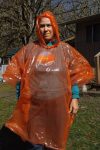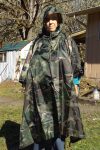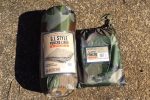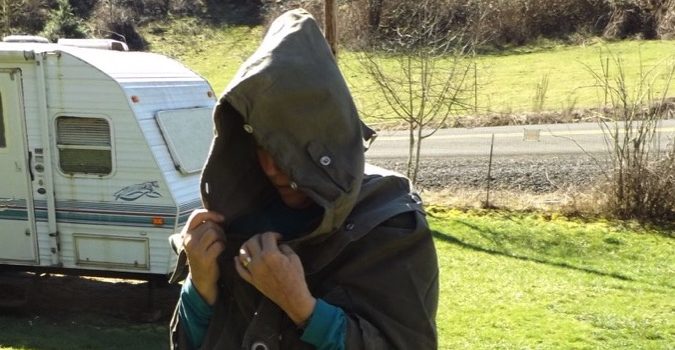A poncho is something so simple and inexpensive, yet it can save your life. I don’t suppose anyone really knows when the poncho was invented, but it has been around for a lot of years. Prior to the poncho, at least here in the USA West, cowboys and ranchers wore a “slicker” when it was raining. It was nothing more than a long coat, usually heavy canvas duck material, that was impregnated with something like beeswax or similar waterproofing material, that repelled the rain. The only thing was, your lower body still got pretty wet when riding a horse.
In the First World War, our troops wore ponchos in the trenches in France, but they didn’t do a lot of good, when our boys were in the trenches, with mud and water up to their knees, and even higher. In Vietnam, the monsoon rains drenched our soldiers, even when they wore a poncho. So, there is no really great solution to staying dry – for the most part.
On Patrol
Allow me to digress a little bit: Back in 1979, I worked as a K-9 handler, and our job was to patrol around a nuke plant – no longer there. We patrolled from sunset, until sunrise – usually a good 12-hour shift, not counting the drive there and back home – which was about an hour each way. And, of course, kenneling our dogs and caring for them at the end of the day. I took this job in early Fall, and that’s about the time the heavy rains would begin. Newly married, we didn’t have a lot of money, however, back then, I was getting paid $10.00 per hour – that was triple the minimum wage. After a few nights of getting drenched and shivering, I bought a rain suit, to go over my insulated coveralls. Thought I had the rains beat. Nope!
The rain suit – pants and hooded jacket – kept me dry – on the outside. However, my body would sweat, causing me to get drenched on the inside – it was a no-win situation – even my feet got wet on the inside of my government issue rubber boots. Plus, to top it off, we had Dobermans as our partners, and they are short-haired dogs, and about halfway through the night’s shift, they would start shivering and there was no way to keep them warm and dry. I felt bad for my dog. They couldn’t wait to get kenneled, so they could eat, drink and crawl into their protected enclosure and get dry.
For some stupid reason, I never thought about buying a US military poncho, even though I used one heavily, when stationed at Ft. Lewis, Washington for my Infantry school in 1969 – and anyone knows it rains a lot in the Pacific Northwest. Yes, your lower legs and feet would get wet – when not wearing overshoes, but the rest of your body mostly stayed dry if you didn’t do a klutzy tumble.
My family and I have been Preppers (used to be called “Survivalists”) for a lot of years – before I was married, I was a “Survivalist” – even when I was a kid. So, over the years, we’ve had the chance to experiment with a lot of different survival gear, learning over the years, what worked and what didn’t work. Believe me, I’m no expert in anything, just a serious student, who is still learning.
European Surplus Ponchos
 At least 25 years ago, we purchased something a little different, and I don’t remember where these “ponchos” came from. However, these European military surplus ponchos are super-heavy cotton canvas, and they are also used as a shelter half. And, when I say, these are heavy material, I mean just that. You have to have a battle buddy, you carry one half of the shelter and your battle buddy, the other half – they are really great pup tents if you can find some dry ground to pitch them on – there is no floor when you have them assembled into a shelter half. Each shelter half comes in a small cotton canvas pouch, that also holds the tent stakes. These were military surplus, from some un-named country’s military in Europe. However, they were brand-new – never used.
At least 25 years ago, we purchased something a little different, and I don’t remember where these “ponchos” came from. However, these European military surplus ponchos are super-heavy cotton canvas, and they are also used as a shelter half. And, when I say, these are heavy material, I mean just that. You have to have a battle buddy, you carry one half of the shelter and your battle buddy, the other half – they are really great pup tents if you can find some dry ground to pitch them on – there is no floor when you have them assembled into a shelter half. Each shelter half comes in a small cotton canvas pouch, that also holds the tent stakes. These were military surplus, from some un-named country’s military in Europe. However, they were brand-new – never used.
We assembled our two pairs of them into two pup tents, and treated them with some spray-on water-proofing spray, to make sure they didn’t leak, and tested them against a garden hose. They worked great. However, when you took that little pouch that the shelter half came in, and attached it to make a hood – well, that was another story. First of all, the hood – like many other military ponchos are designed to be worn with a combat helmet – without one on your noggin’ its hard to see with the hood on your head. Still, all-in-all, the idea is a good one, just very heavy.
Swiss Surplus Ponchos
 Some years ago, we purchase some more military surplus ponchos and this time, they came from the Swiss military as surplus. They too came to me brand-new. They have what is called the Alpenflage camo pattern. Even though it has some red colors, it is a very effective camo pattern. These ponchos are nicely designed and easy to use, just put it on over your clothing, and they keep you really dry in a monsoon. One drawback to the Swiss poncho is that they are heavy plastic – and they are some kind of plastic – and did I mention they were heavy – and bulky?
Some years ago, we purchase some more military surplus ponchos and this time, they came from the Swiss military as surplus. They too came to me brand-new. They have what is called the Alpenflage camo pattern. Even though it has some red colors, it is a very effective camo pattern. These ponchos are nicely designed and easy to use, just put it on over your clothing, and they keep you really dry in a monsoon. One drawback to the Swiss poncho is that they are heavy plastic – and they are some kind of plastic – and did I mention they were heavy – and bulky?
Another drawback is that even the sturdy Swiss poncho can rip – not easily rip, but still rip. So, any good Prepper should have a roll of Gorilla Tape in their kit – this is miracle stuff that you will find yourself using all the time on your gear. Left untreated, even a small rip in this poncho, will grow bigger – so a minute or two, with some Gorilla Tape, on the tear, and you are good to go. I like these ponchos and you can still find them on the market if you shop around. As I recall, they were only like $20 for a package of four of them — quite a deal. And, you can use them as a lean-to if need be.
The Cheapo Ponchos
 Next up are those thin plastic emergency ponchos that you can find in any big or small box discount store – they are a buck to a buck and a half each. They come in various colors, too – but as mentioned they are thin – thinner than a plastic garbage bag. However, they are very compact, and you can easily carry one in your pants pocket or purse if you are out and anticipate some rain. For the most part, they are a one-time use poncho. But you could probably re-use them if you carefully dry them after a rain and fold them back up. These are not a poncho that you want for your long-term BOB. simply won’t stand up to any harsh use. Still, we all keep one in our BOB as a back-up to whatever we might need one for.
Next up are those thin plastic emergency ponchos that you can find in any big or small box discount store – they are a buck to a buck and a half each. They come in various colors, too – but as mentioned they are thin – thinner than a plastic garbage bag. However, they are very compact, and you can easily carry one in your pants pocket or purse if you are out and anticipate some rain. For the most part, they are a one-time use poncho. But you could probably re-use them if you carefully dry them after a rain and fold them back up. These are not a poncho that you want for your long-term BOB. simply won’t stand up to any harsh use. Still, we all keep one in our BOB as a back-up to whatever we might need one for.
The USGI Option
 There are many different types of ponchos on the market, and we can’t begin to cover them all. But I certainly want to cover the USGI poncho. You can find them brand-new on the market for about $50. However, we found some USGI “type” of ponchos for under $20 and they are every bit as good, if not better than the genuine U.S. military issue. Plus, they can be had in several colors, not just like the color de jure that that military issues. These ponchos are the exact same design at the real deal in all respects. Plus, they are designed with ripstop nylon thread grid, so if you get a rip in it, it won’t spread – nice, very nice! Given our locale in Oregon, we all elected to get our ponchos in the woodland camo pattern.
There are many different types of ponchos on the market, and we can’t begin to cover them all. But I certainly want to cover the USGI poncho. You can find them brand-new on the market for about $50. However, we found some USGI “type” of ponchos for under $20 and they are every bit as good, if not better than the genuine U.S. military issue. Plus, they can be had in several colors, not just like the color de jure that that military issues. These ponchos are the exact same design at the real deal in all respects. Plus, they are designed with ripstop nylon thread grid, so if you get a rip in it, it won’t spread – nice, very nice! Given our locale in Oregon, we all elected to get our ponchos in the woodland camo pattern.
 These ponchos are from VooDoo Tactical – you can find them at MajorSurplus.com. I should mention that we’ve shopped their products for at least 25+ years and find great bargains. The only thing is, you can’t find nearly the variety of military surplus that they used to have – not US nor foreign-made military gear. Yeah, they still have some, but not much, and that is unfortunate. These ponchos come in a nice little bag, and take up very little room in a BOB or in our case, on the bottom of our butt packs – strapped in tightly. These are easily worn. Just take it out of the package, and put it on – no problems at all. And they are totally waterproof – just like the USGI one is.
These ponchos are from VooDoo Tactical – you can find them at MajorSurplus.com. I should mention that we’ve shopped their products for at least 25+ years and find great bargains. The only thing is, you can’t find nearly the variety of military surplus that they used to have – not US nor foreign-made military gear. Yeah, they still have some, but not much, and that is unfortunate. These ponchos come in a nice little bag, and take up very little room in a BOB or in our case, on the bottom of our butt packs – strapped in tightly. These are easily worn. Just take it out of the package, and put it on – no problems at all. And they are totally waterproof – just like the USGI one is.
Also Get a Poncho Liner
One thing that I should mention is that Major Surplus sells a poncho liner, that attaches inside of your VooDoo poncho, and it can be used as a make-shift sleeping bag. And, a poncho liner weight next to nothing and is easy to carry on your BOB. Get one! It only takes a few minutes to attach this poncho liner to your poncho, and fold it over and crawl into it – these poncho liners are incredibly warm, believe it or not. You can Google how to attach a poncho liner to a poncho in the ‘net – so I won’t list all the websites here.
When I was in the military, our poncho liners had a slit cut into them, so you could actually wear the poncho liner inside of your poncho for added warmth. The VooDoo Tactical poncho liners don’t have this slit – then again, I never worn a poncho liner attached inside of my poncho while wearing a poncho. Still, you can have a slit cut into the poncho liner that will fit over your head if you want to wear it under your poncho. BTW, these poncho liners are only $20 – and well worth it – even if you never use it inside of your poncho. I’ve found that they make a great light covering if you are watching television, and the heat is turned down.
If you don’t have a poncho in your BOB or camping gear, you aren’t fully equipped for nasty weather – they are also great to use in the snow – will help keep you dry. I highly recommend the VooDoo Tactical US GI-style poncho from Major Surplus. They are a great deal for the price and will last you a lifetime with a little bit of care. Just make sure you have them totally dried out after use, before folding them back up. If you don’t then they will mildew.
We’ve experimented with a lot of ponchos over the years, and the USGI type is still the best of the best, if you ask me. You need one, so get one!










